William_Potter/iStock via Getty Images
Author’s note: This article was released to members of the CEF/ETF Income Laboratory on January 14, 2022.
The Global X SuperDividend Emerging Markets ETF (SDEM) is an emerging market equity index ETF, which invests in the 50 best performing emerging market stocks. The fund offers investors a strong and growing dividend yield of 8.1% and a cheap valuation. On the other hand, the fund’s holdings are significantly riskier than average and have significantly underperformed since inception. In my opinion, the benefits of the fund outweigh its positives, and therefore the fund is a buy, but it is only a suitable investment for more aggressive investors.
Basic Principles of SDEM
Presentation of SDEM
SDEM is an emerging market equity index ETF. It tracks the MSCI Emerging Markets Top 50 Dividend Index, a fairly self-explanatory index, which includes the 50 best performing emerging market stocks. SDEM’s investment manager provides a simple summary of the index methodology, which I think all interested investors should read. The index includes the highest paying emerging market stocks that meet the following conditions.
The last two criteria aim to exclude stocks with unsustainable dividends. While this focus and approach has a lot of merit, the index has more flexible criteria for existing constituents, which mitigates the impact of the above.
SDEM corporate website
Finally, it is an equally weighted index, with rules intended to ensure a minimum of diversification.
SDEM corporate website
Overall, SDEM’s underlying index looks quite reasonable, but a greater focus on dividend sustainability would have been ideal.
The SDEM itself is a moderately diversified fund. It is exposed to most relevant industry segments, but is overweight the relatively risky Materials and Energy sectors, as well as Real Estate and Financials, which have medium risk and volatility. These four sectors are currently posting above-average dividend yields, hence their increased exposure.
SDEM corporate website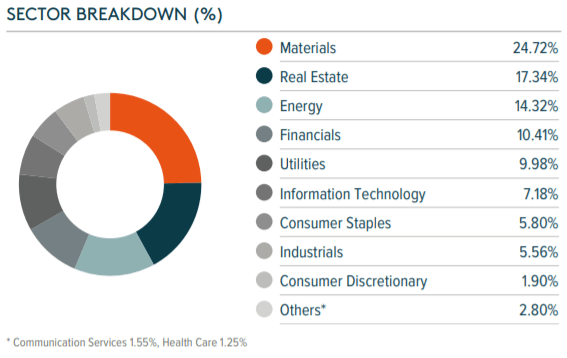
SDEM’s focus on materials and energy increases the fund’s exposure to commodity prices, which significantly increases portfolio risk and volatility. Expect the fund to outperform moderately when commodity prices rise, as it did last month.
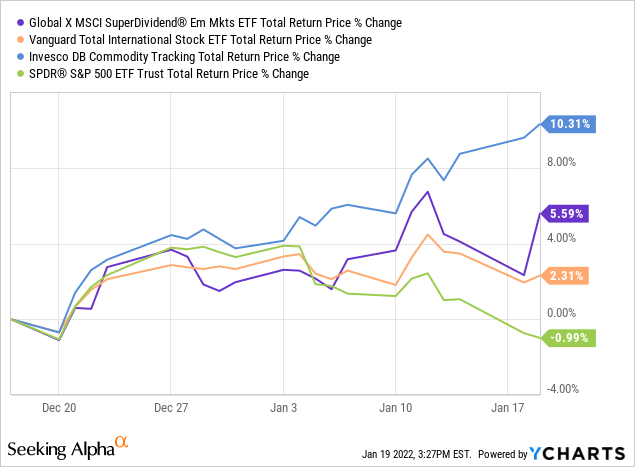
Expect the fund to underperform moderately when commodity prices fall. Commodity prices have mostly been on a downward trend in recent years, so there are many periods that one could cite, but 2015, the last major commodity/oil price crisis, seems to be a particularly revealing example.
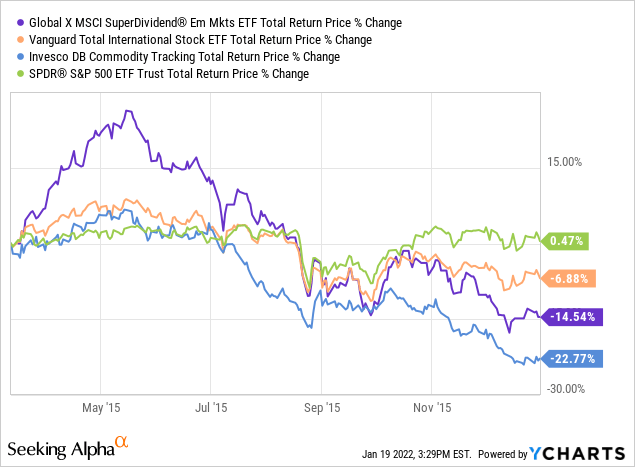
As commodity prices are by nature quite volatile, SDEM’s increased exposure to them makes the fund a relatively risky investment.
SDEM invests in securities from fourteen different countries, but is overweight East Asia, particularly China. There is relatively little exposure to Latin America, Eastern Europe or the Middle East. SDEM’s geographic diversification is reasonably good, but below average for an emerging market equity index ETF.
SDEM corporate website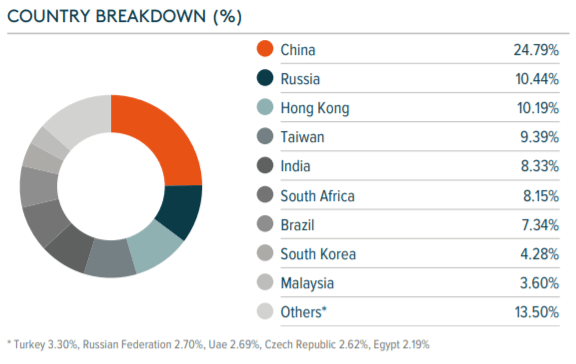
Since SDEM is an equally weighted fund, its major holdings are not particularly informative or material. However, for reference, the largest holdings in the fund are as follows.
SDEM corporate website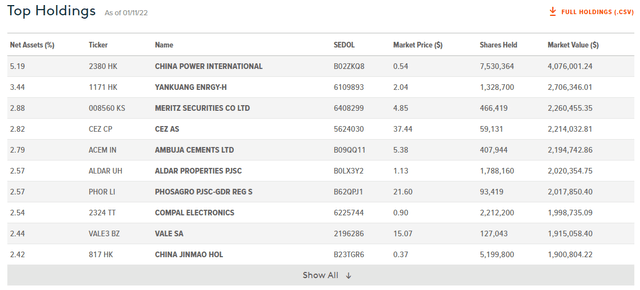
SDEM is a reasonably well-diversified fund, but certainly not as diversified as most comparable index funds. SDEM’s low diversification is due to its relatively small number of holdings, 50, and its focus on high yield stocks. Since SDEM focuses on emerging market equities, a relatively small market niche, and the fund lacks diversification, small positions are ideal. I wouldn’t go above 5%.
Although SDEM’s underlying index has some issues, the result is a fund with two clear advantages. Let’s look.
SDEM – Investment Thesis and Benefits
Strong and growing dividend yield of 8.1%
SDEM invests in the 50 highest paying emerging market stocks, which naturally leads to a very high dividend yield for the fund. SDEM itself is posting a year-over-year return of 8.1%, quite solid in absolute terms and well ahead of most equity indices and its peers.
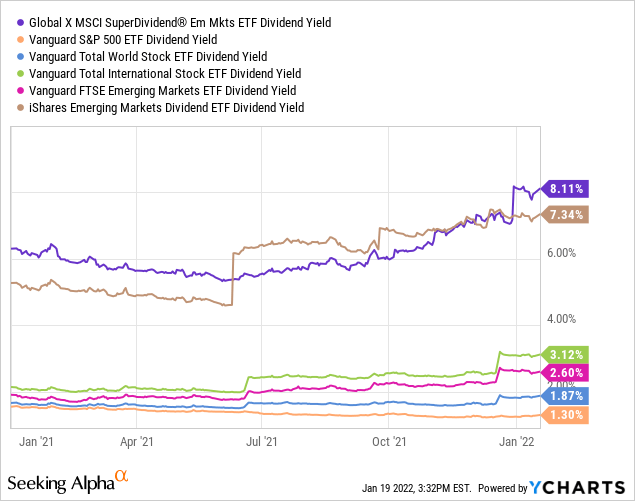
SDEM’s strong 8.1% dividend yield is a significant benefit to the fund and its shareholders, and the fund’s core investment thesis. It is an income vehicle that investors buy for yield.
SDEM’s dividend has also seen some growth since its inception, although the situation is somewhat complicated. SDEM paid a special return of capital distribution in December 2021. Due to structural and regulatory issues, it is rare for ETFs to make these distributions. There are exceptions, however, mostly centered on the distribution of excess returns in niche asset classes, including derivatives and foreign equities. With returns having been particularly strong in 2021, some ETFs were forced to issue special distributions at the end of the year, including SDEM. Disregard said special distribution, and we can say the following.
SDEM has seen positive dividend growth since inception, with the fund’s dividend growing at an annualized rate of 1.0% since 2015. This is a relatively lackluster, but positive, growth rate and a small plus for the fund and its shareholders. Importantly, growth has accelerated this year, with the fund’s dividend increasing a massive 53% in 2021 alone, from $0.0575 to $0.0880. As such, and assuming the fund’s current dividend will be maintained through 2022, SDEM is currently showing a forecast dividend yield of 9.4%, which is pretty solid. Apart from the fund’s special distribution, these dividends are also entirely financed by the underlying income generation and are therefore (currently) sustainable. We’ll have to wait and see how the fund’s dividend plays out in 2022, but I think a forward dividend yield of +8.0% is a reasonable expectation and a significant upside for investors.
On a more negative note, the fund’s dividends are neither stable nor secure. Volatility and dividend cuts are both quite common, especially during downturns and recessions. SDEM’s dividend was cut by just over 30% in the aftermath of the coronavirus pandemic, although dividends have since recovered.
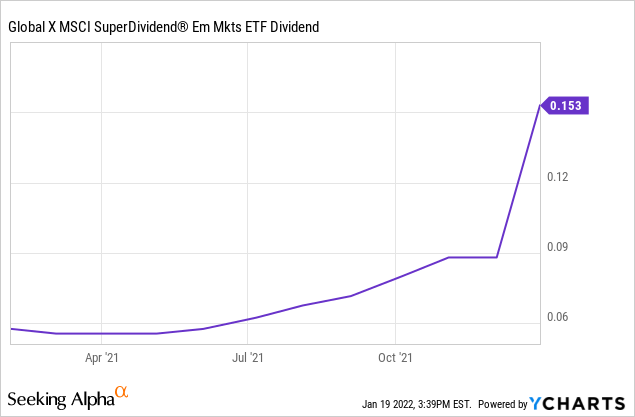
SDEM’s strong and growing 8.1% dividend yield is a significant benefit to the fund and its shareholders, but it is a relatively risky dividend.
Cheap assessment
SDEM focuses on emerging market equities, which offer some relative value. Emerging market stocks are currently trading at significantly lower valuations than US stocks, according to JP Morgan. US equities are also trading at historically above-average valuations, while emerging market equities are trading at near-average valuations.
JP Morgan Guide to the Markets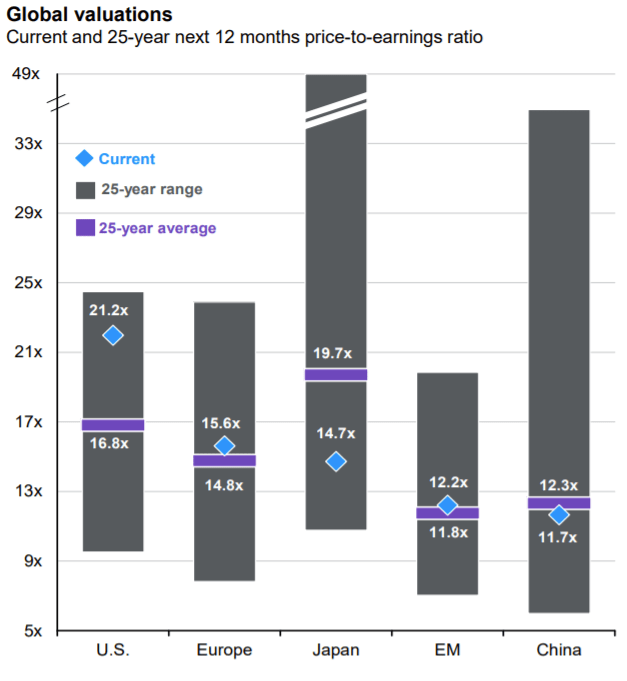
SDEM itself sports an incredibly cheap valuation, with a PE ratio of 5.7x and a PB ratio of 0.9x. Both of these ratios are incredibly low and well below those of most broad-based equity index funds, including those focused on emerging market equities.
Seeking Alpha – Chart by Author
SDEM’s extraordinarily cheap valuation could generate significant capital gains should valuations normalize, a significant benefit for the fund and its shareholders.
SDEM – Risks and Negatives
SDEM is a solid fund and an investment opportunity, but it also comes with significant risks, downsides and downsides. Two stand out: its risky holdings and its long-term underperformance. Let’s look at these two issues.
Risky assets
SDEM focuses on emerging market equities. These securities tend to be riskier than comparable US stocks due to currency risk, corporate governance issues and weak economic fundamentals. SDEM further focuses on high yield stocks, which tend to be riskier than average: returns would not be high otherwise. The fund further focuses on the volatile materials and energy sector, which experiences strong price swings due to fluctuations in commodity prices. These three characteristics or objectives result in an incredibly risky and volatile fund. Investors should expect wild swings in the fund’s share price, as well as large losses during downturns and recessions. For example, SDEM significantly underperformed in 1Q2020, at the start of the coronavirus pandemic.
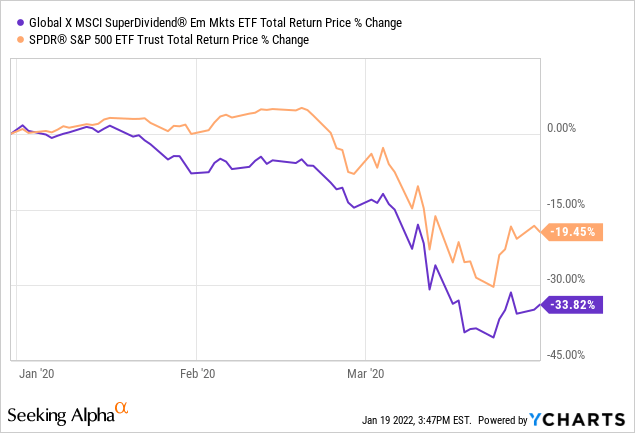
Due to the above, SDEM is only appropriate for more aggressive income investors and retirees.
Long-term underperformance
SDEM focuses on emerging market equities, high yield equities, and the materials and energy sectors. Each of these individual sectors has moderately underperforming for years. Their combination/intersection in SDEM has, understandably, underperformed since inception as well, and by quite a significant margin.
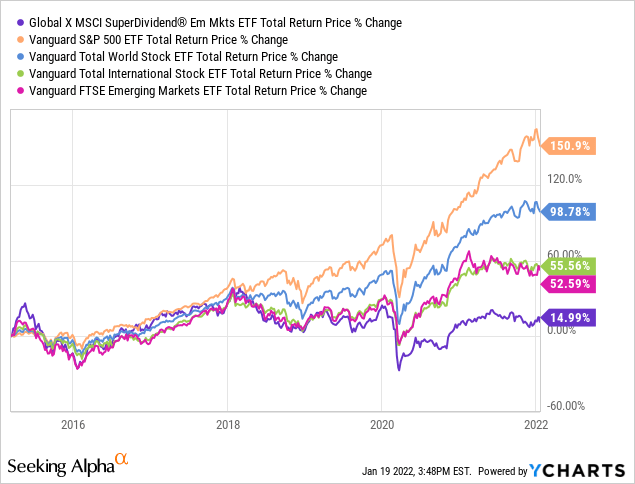
SDEM’s long-term underperformance is a significant negative for the fund and its investors, but will not necessarily have an impact going forward. Rising commodity prices, changing investor sentiment and increased investor inflows into low-value sectors and industries led the fund to outperform over the past month. I think these trends will continue and the fund should outperform going forward, but that’s obviously far from certain.
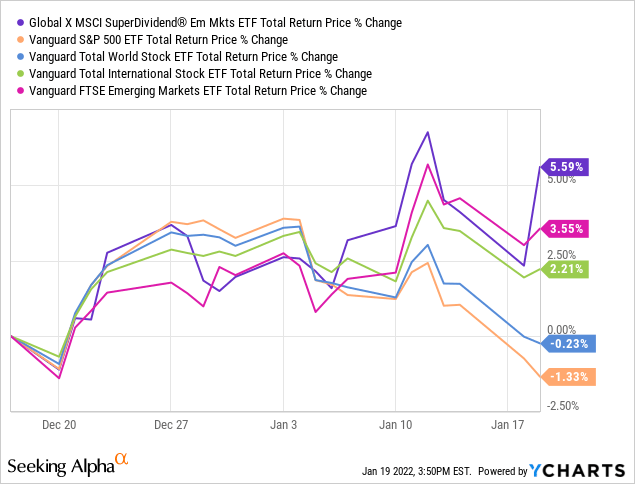
Conclusion
The strong and growing dividend yield of 8.1% and SDEM’s cheap valuation make this fund a buy. Due to the fund’s risky holdings and long-term underperformance, it is only suitable for more aggressive income investors and retirees.

